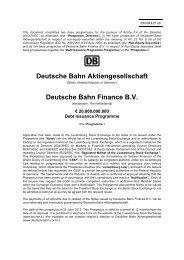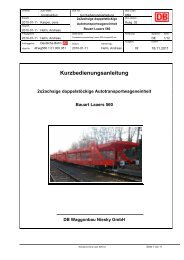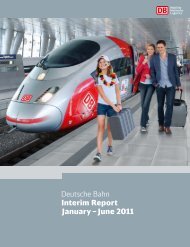PDF Download - Deutsche Bahn AG
PDF Download - Deutsche Bahn AG
PDF Download - Deutsche Bahn AG
Create successful ePaper yourself
Turn your PDF publications into a flip-book with our unique Google optimized e-Paper software.
|<br />
mAN<strong>AG</strong>EmENT rEPOrT<br />
Due to the targeted price policy used by the freight forwarders<br />
in the previous year, the price level noted at the start of 2010 was<br />
relatively low and did not rise significantly over the entire year<br />
as competition remained very intense. In order to realize further<br />
cost savings, especially in the first half of 2010, some frequencies<br />
were reduced in the freight forwarders’ networks. Based on<br />
revenues, which fell by almost 20 % in the depressed land trans-<br />
port market in the previous year, the market rebounded by about<br />
8 % in 2010. We grew at a faster rate than the market average.<br />
DB Schenker was therefore able to retain its position as the<br />
leader in the European land transport market.<br />
AIR FREIGHT<br />
The previous year’s decline of over 10 % in volume transported<br />
posed a challenge to all players in the air freight market. The<br />
collapsing market led to reductions in network capacity by air<br />
freight forwarding companies and, above all, the airlines.<br />
Numerous airplanes were taken out of service to remove surplus<br />
capacity from the market. However, these measures were not<br />
enough to avoid a sharp drop in shipping rates. A substantial<br />
stabilization in shipping volumes was once again observed since<br />
the fourth quarter of 2009. Driven by strong development in<br />
Asia, overall development of the air freight market was very<br />
favorable and also continued into 2010. While routes between<br />
Asia and North America or Europe, as well as inner-Asian routes,<br />
posted strong increases in tonnage shipped, volume shipped<br />
from North America to Europe as well as the domestic air freight<br />
business within the USA posted less than average growth.<br />
On an overall basis the market gained by 20.6 % over the<br />
previous year and could surpass the pre-crisis level. This significant<br />
recovery exceeded expectations and led to capacity bottlenecks<br />
and sharp rises in rates, especially in the first half of 2010. many<br />
of the previously decommissioned airplanes were brought back<br />
to service in order to meet heavy demand. We also benefited<br />
from the rapid recovery. DB Schenker Logistics grew at the same<br />
pace as the market and was thus able to retain its market position<br />
and to almost reach the pre-crisis level it had attained in 2008.<br />
OCEAN FREIGHT<br />
The ocean freight market also posted very favorable development<br />
in 2010. Volumes and freight rates on all trade routes recovered<br />
notably since mid-2009. This made it possible for the shipping<br />
companies to offset nearly all of the heavy losses they incurred<br />
in the previous year. This was mainly due to the shipping companies’<br />
forward-looking capacity management measures that enabled<br />
them to push through higher rates by restricting cargo space and<br />
equipment. It is anticipated that global container volume for<br />
2010 expanded by about 13 %. On key routes from Asia to Europe<br />
the increase in container volume was about 23 %, nearly 17 % from<br />
Asia to North America, and about 7 % on inner-Asian transport.<br />
The approximately 16 % increase in volume over the previous<br />
year posted by DB Schenker Logistics in 2010 was once again<br />
substantially stronger than the figure recorded for the total<br />
market. DB Schenker Logistics thereby asserted its market<br />
position. Both the total market as well as DB Schenker Logistics<br />
have already surpassed their pre-crisis level seen in 2008.<br />
CONTRACT LOGISTICS<br />
After the market for Contract Logistics/Supply Chain management<br />
(SCm) declined in the previous year based on revenues by about<br />
5.4 % due to the global recession, strong growth was once again<br />
achieved in the year under review. The contract logistics market<br />
is thus more resistant than the transport markets due to its<br />
longer-term contractual relationships and the outsourcing rate,<br />
which is still increasing. During the year under review, capacity<br />
utilization continued to rise, and good order volumes were seen<br />
both domestically and internationally. Production volumes for<br />
all of the core industries at DB Schenker Logistics (automotive,<br />
consumer and electronics) were significantly higher than in the<br />
previous year.<br />
Favorable development was noted in all of the key countries<br />
and regions, especially in the emerging markets. With revenue<br />
growth of 14 %, DB Schenker Logistics developed much more<br />
strongly overall than the total market, which grew by about 6 %<br />
and was thus able to maintain its market position.<br />
15

















